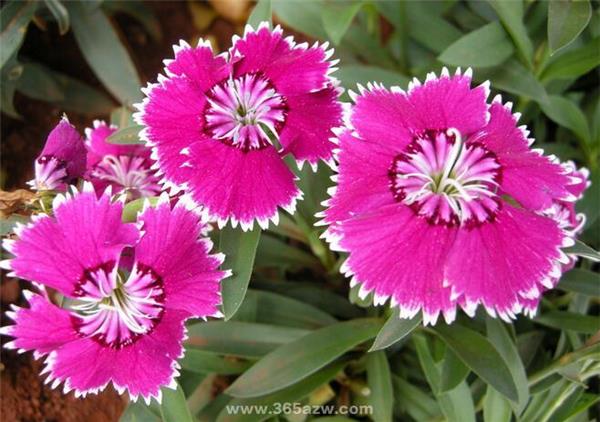Introduction to the methods of Carnation Culture
Carnation flowering small and delicate, very pleasing to the eye, loved by people, carnation as a potted plant culture should pay attention to what problems? The following is a detailed introduction for you.

Carnation is cold-resistant, drought-resistant, not resistant to heat, poor growth or withering in summer, so attention should be paid to shading and cooling during cultivation. Like sunny, dry, ventilated and cool humid climate. Require fertile, loose, good drainage and calcareous loam or sandy loam, avoid waterlogging, good fertilizer. Alkali-resistant soil is better. But because of its stem node, inflated like bamboo, hence the name. Carnation is a perennial herb, evergreen. But it is generally cultivated and cultured for one or two years. Autumn sowing in the north, flowering in spring; spring sowing in the south, summer and autumn blooming. The plant of carnation is 30-40 cm tall and erect in clusters. Stems erect, articulate, much branched, leaves opposite, striate or linear-lanceolate. Calyx tube round, single or several flowers clustered at the top of the stem, forming Cymes, flower diameter 2-3cm, flowers with bright red, pink, purple, pure white, red, variegated, single or double, apex serrate, slightly fragrant. The middle and lower part of the positive side of the petals form a beautiful black ring. When the petals are in full bloom, the petals are flashy and colorful. The florescence is from April to October and is concentrated from April to May. Capsule moment orbicular or oblong, seeds oblate, dark brown.
The culture method of carnation:
1. Soil: clayey soil which requires good drainage, rich humus, good fertilizer retention and slightly alkaline, can be mixed with 6 parts of garden soil, 2 parts of compost and 2 parts of sandy soil.

2. Watering: the growth of carnation is strong and resistant to drought. In rainy and wet areas, the soil is easy to harden and the root system develops abnormally due to poor ventilation, so attention should be paid to loosening the soil and drainage in the rainy season. Except for timely watering during the growing and blooming season. It is advisable to keep the soil moist by watering less at ordinary times.
3. Temperature: the suitable temperature for the growth of carnation is 15-20 ℃. In winter, the temperature should be kept above 12 ℃ in the greenhouse. The air wettability should be kept at about 75%, and proper spraying of water before flowering can prevent the bud from cracking in advance.
4. Fertilization: Carnation likes fertilizer, applying sufficient amount of baking fertilizer and bone powder before planting, and applying liquid fertilizer continuously during the growing period, generally applying mature thin fertilizer and water every 10 days or so, and applying topdressing after flower picking.
5. Lighting: ensure 6-8 hours of light every day. At the height of summer, the carnation flower is in a semi-dormant state, so we should pay attention to avoid the hot sun exposure. Avoid stagnant water in the basin, otherwise the roots are easy to rot.
6. pest control: the common diseases of carnation are calyx rot, scab, gray mold, bud rot and root rot. Dysen zinc can be used to control calyx rot and rust pentoxide to prevent calyx rot. In the control of other diseases, benzoate zinc, carbendazim or carbendazim were used to treat the soil before planting. When it comes to red spiders and aphids, it is usually killed with 1000 times of dimethoate emulsion.

Maintenance of carnation potted plants:
The suitable temperature for the growth of potted carnation flowers is 15-20 ℃. In winter, the temperature should be kept above 12 ℃ in the greenhouse. The growing period requires sufficient light, placed in a sunny place, and it is appropriate to scatter light in summer to avoid hot sun exposure. When the temperature is high, it should be shaded and cooled down. Require fertile, loose, good drainage and calcareous loam or sandy loam, avoid waterlogging, good fertilizer. It is required to apply sufficient base fertilizer, 2-3 plants per pot. When the seedling grows to 15 meters high, it is necessary to remove the terminal bud and promote its branching, and later pay attention to the proper removal of axillary buds, otherwise more branches will disperse nutrients and blossom small. proper removal of axillary buds to concentrate nutrients can promote large and colorful flowers.
During the growth period, the potted carnation should be maintained in a sunny and well-ventilated place to keep the basin soil moist and apply mature thin liquid fertilizer every 10 days or so. There are too many Rain Water in summer, pay attention to drainage and loosen the soil. Some leaf axillary buds should be removed in time before flowering, mainly to ensure that the top buds bloom. It is advisable to water less in winter, such as keeping the temperature at 5-8 degrees, blooming continuously in winter and spring.

The above is the introduction of carnation culture, I hope it will be helpful to you.
Related
- Wuhan Hospital Iron Tree Blooming Result Was Instantly Frightened by the Gardener Master
- Which variety of camellia is the most fragrant and best? Which one do you like best?
- What is the small blue coat, the breeding methods and matters needing attention of the succulent plant
- Dormancy time and maintenance management of succulent plants during dormancy
- Minas succulent how to raise, Minas succulent plant pictures
- What are the varieties of winter succulent plants
- How to raise succulent plants in twelve rolls? let's take a look at some experience of breeding twelve rolls.
- Attention should be paid to water control for succulent plants during dormant period (winter and summer)
- Watering experience of twelve rolls of succulent plants
- Techniques for fertilizing succulent plants. An article will let you know how to fertilize succulent plants.



